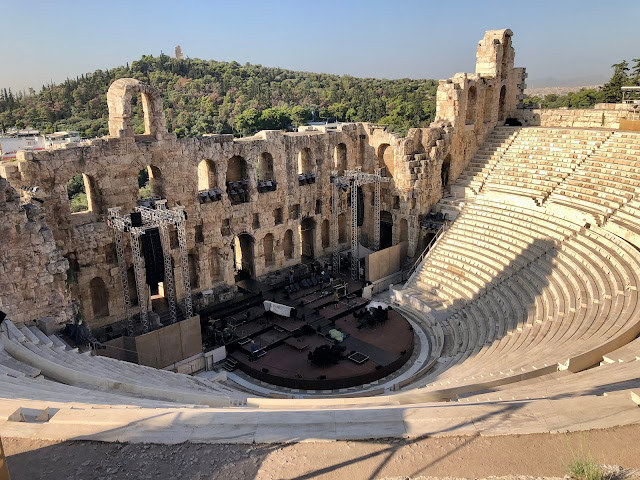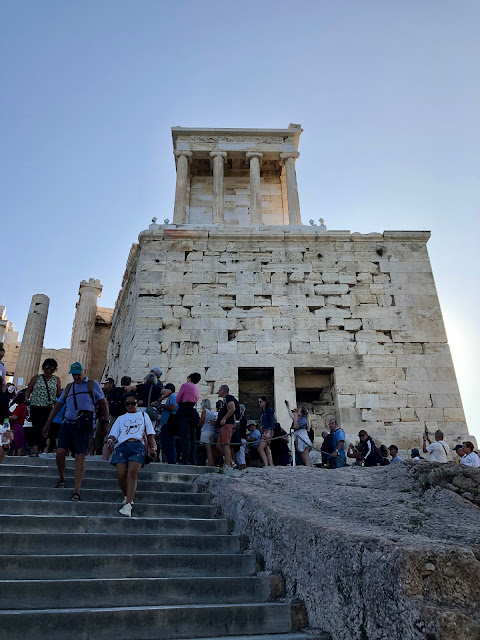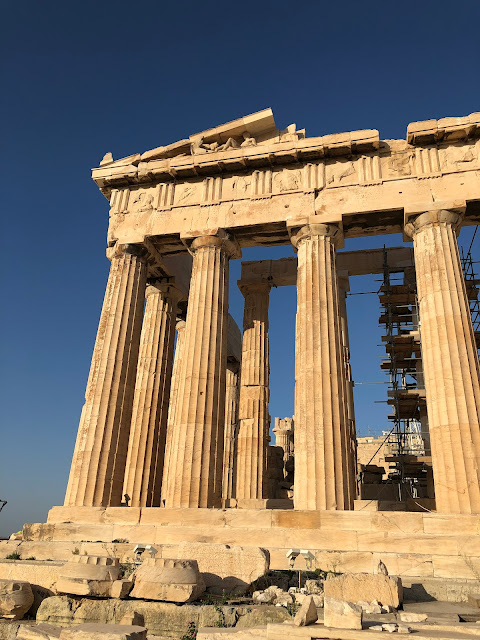I start this post that way for two reasons. First, it's a get out of jail free card on the photos in this post. I didn't plan on writing a Greek food post so I didn't consciously take pictures to support a narrative. That's not a comment on our expectations for Greek food. I just didn't plan one.
Second-ly, and way more importantly, the food in and around Athens was quite honestly amazing. Greece deserves a food post. When people ask me where I've traveled and have had the best food, I always say Japan. My answer may now be Greece. It was that good. No joke here. It was incredible. And way, way, way cheaper than Japan.
So before I continue and finish blogging about Greek temples...here goes a food post about Greece. With sub-par photographs.
 |
| Souvlaki, anyone? |
So, a few big picture themes here: (1) lots of the best feta I have ever had in my life (and I already LOVED feta before this trip); (2) lots of olives (kalamatas, the BEST kind of olives); (3) lots of souvlaki; and (4) lots and lots of history and influences from other cultures that put Greek cuisine where it is today. Combine all of that with an awesome street food scene; low, low, low costs; and good and cheap Greek wine (I'm partial to the malagousia) and honestly, I could spend weeks roaming around Athens eating the food that the locals cook. Seriously impressive.
Now, for sure, we were serious about getting some good Greek grub before we arrived in country. I definitely had feta, pastries made from phyllo, souvlaki and baklava (I know...also made from phyllo) on my list along with a resolution to find the best I'd ever had of each of those foods. I also thought the food was important enough in this part of our Croatia and Greece trip to book a food tour on our arrival day in Athens. We've done this in a few places around the globe and have found they not only get us a good sampling of the local fare, but also get us a feel for neighborhoods around wherever we are traveling in addition to making connections locally and regionally through the history of what's eaten where we happen to be.
None of that makes any sense with my I-wasn't-planning-on-food-blogging statement but whatever.
Our food tour idea (Greekality's Athens Street Food Tour, if you must know) totally worked as intended. It got us deep into the casual food and street food scene (and I really love some street food) around Syntagma and particularly Monastiraki Squares and gave us a place to head back for both lunch and dinner over the next couple of days. Our guide, Antonia, also gave us advice and tips for our next three days in town and also walked us through the history and some of the etymology of both the places we were visiting and the foods we were enjoying. She also below away some preconceived notions about food in Greece, particularly some things we get wrong over here in the USA.
Let me drop a couple of word origins here to get things going: any word with "aki" on the end is likely a diminutive of the original meaning (Monastiraki Square is a smaller version of an open space near the monastery in that part of town) and the addition of "pita" on the end of a word typically means a pie, particularly if it's a phyllo pie (spanakopita comes to mind here). Antonia also informed us about the dropping of the "s" on Acropolis and metropolis (it's pronounced Acropoli and metropoli in Greek) due to those two words being feminine in gender.
 |
| Our guide, Antonia, with some cheese (meaning feta, of course) pie. |
So about that food. Let's start with dessert, shall we? I mean, why not. Dessert always comes last. Why not put it first for a change.
If there was a dessert we had to have in Greece, it was baklava. Layers of phyllo sandwiched over and below layer after layer of finely chopped pale green pistachios and then the whole thing drenched in honey? Yes, please. Sad though it may sound, my measuring stick for baklava was a stall at London's Borough Market and I knew I was bound to get something better than that in Greece. So on the first night in Athens as the last dish of our food tour we were presented with a plate of baklava with orange cake and ice cream.
So was it a better version of the roll of baklava I had in London? No, it was not. And that's because it wasn't the same kind of baklava. The Greeks don't make their baklava with pistachios. They make it with walnuts. The Greeks also throw in a healthy dose of cinnamon when they are making their baklava. But honestly (and despite pistachios being superior to walnuts), it was really, really good. It was actually better than the stuff in London. By a lot.
That's not to say that there isn't pistachio baklava out there that's better than the walnut variety that we had in Athens but this couple of bites was really good. We did actually find some pistachio baklava on the island of Aegina but that was not as good as the walnut and cinnamon stuff.
In case you were wondering, the Turks make the pistachio baklava.
 |
| Baklava, orange cake and mastika ice cream. |
Baklava was just one of four desserts we had on our first night food tour (I'm counting the orange cake and the ice cream as two separate desserts...). The ice cream that filled the left side of the baklava plate was made with mastika, a resin produced by the mastic tree on the Greek island of Chios. Apparently, despite the mastic tree existing in many places in the world, it only produces resin on the Chios just west of the coast of Turkey. I am betting we never find mastika ice cream in any other country in any of our future travels. The stuff you learn when you leave home...
The first dessert we had that night was the most disappointing...something called lukumades, which are deep fried balls of dough with honey topping (think donut holes but a bit larger). I found them too deep fried. They were crunchy when I expected soft and they left me with a greasy aftertaste in my mouth. But they came with a small dose of history: apparently they were served as prizes for the ancient Greek athletes at the first Olympic Games in 776 B.C., which I guess makes the Greeks the inventors of the donuts, at least until someone tells us about an earlier version.
A "single bite" in Arabic is lukma, by the way.
 |
| The Lukumades napkin. In many ways better than the actual food. |
More food, anyone? With or without history? For sure! The sampling of spanakopita and just plain cheese (meaning feta) pie we started our tour with was the best phyllo with spinach and cheese or just cheese that I've ever had. I don't know how anyone could eat a whole portion of one of these pies but I guess people do. Way too rich and buttery but awesome in single bite form.
The best we had on our first night, though, was a peyrnirli. I know what you are thinking...a WHAT? It's essentially a Greek pizza shaped like a boat, but there's an awesome and sad historical backstory.
The peyrnirli is not Greek. It's Turkish. Shocker, I know. The Turks! Again!
Apparently in the late nineteen-teens and early 1920s the Greeks and the Turks got into a bit of a war. The Greeks started it when they invaded western Turkey in 1919 and the Turks ended it when they kicked the Greeks back to Greece three years later. The Greeks invaded because they claimed the Greek-speaking Orthodox Christian population living in western Turkey needed protection from the Turks. So when the war was over, the two countries agreed to swap parts of their population: the Turks sent 1.1 million Christians to Greece and the Greeks sent 400,000 Muslims the other way. When that happened, the peyrnirli made its way from Turkey to Greece. And in 2023, a couple of peyrnirli made their way from a table to my stomach.
I know it shouldn't shock me because it's happening still all over the world today, but what kind of leaders of nations want to send residents of their own countries away to an enemy and force people in their enemy's territory to uproot their lives and move to a new place? I guess maybe it would be welcomed if those people felt threatened where they lived but why would a nation allow that either? I know there are no good answers here.
But that's apparently how the peyrnirli got to Athens. It's effectively a pizza in a different shape, right? Although (and I know you can't tell from the picture below) there's no tomato sauce. I love pizza, especially ones with pillowy soft crust that deflates gorgeously when you bite into them like these peyrnirli did. The olive ones were the best. Hey...we were in Greece.
 |
| Mushroom and truffle peyrnirli. |
This post was never intended to be a blow by blow of our opening night food tour so while there's still time, let's make sure I don't do that.
We got amazing food pretty much everywhere we went in Greece. Whether it was street food or food in a restaurant or eaten outdoors or indoors, we generally loved everything we ate. Maybe not so much the koulouria, or Greek bagels (they were too dry, even when filled with cheese and bacon), but everything else hit the spot pretty much as soon as we bit into it.
It might be odd to reminisce about something as simple as a Greek salad but I'm telling you, the one we had in our four days in Greece was sublime. Tomatoes, cucumbers, feta, capers, red onions and fall-off-the-pit kalamata olives have never tasted so good in a bowl to me. It was so incredible that I ate all the cucumbers (which I do NOT like) without a care. Oh...and no lettuce. Get it right, America.
 |
| The best Greek salad ever. EVER. |
But after all that, the food that will stick out as intimately tied to our experience in Greece was souvlaki. That's probably because we ate souvlaki four times in four days. It was the main course at dinner on our food tour and it was lunch, lunch and dinner the next three days.
Let's start with the word, shall we. It ends in "aki" so if Antonia is to be believed, it's a diminutive of some other term. And sure enough, the Greek word for skewer is souvla. Souvlaki, therefore, is a mini skewer. Could be chicken, could be pork, could be beef and lamb mixture. If it's chicken or pork, sometimes it's cut off a rotating vertical spit and it might be called a gyro. If it's beef and lamb mixture, it's ground and cooked on a (small) skewer but it's never cut off the vertical spit and it's never called a gyro. Not in Greece. Not since a ban on beef importation in the late 1960s. No beef gyros in Athens.
If it's served as a sandwich, it's coming in a pita. If it's not, it's just on a plate with some sides. Rice and potatoes, maybe. Not rice OR potatoes. Rice AND potatoes. One starch ain't enough here. Throw in some tomatoes, some sauce (tzatziki) and some red onions and you got a meal. And yes, the sides come in the pita, too. Just not the rice. But for sure the potatoes in French fried form. And maybe a bit of paprika.
 |
| Souvlaki, anyone? |
I don't think souvlaki was necessarily my favorite dish in Greece, but it certainly had me coming back again and again. There's nothing that's not good about this sandwich. It's quick, it's relatively healthy (ignore the fries) and it's super cheap. Our last meal of the trip was a couple of chicken souvlakis, a water and beer and it cost us less than $10. That's American dollars after conversion, not Euros. Less than $10!!!
If there are three memories from Greece about food, it's the feta, the olives and the availability and frequency of souvlaki meals. This is not complicated stuff. There's not a lot of advanced techniques required to make anything that we had to eat in Athens or in the area around the Greek capital. It's solid ingredients in the place where they are produced that have been paired together successfully over centuries. Other than the food tour, we made about zero effort to find the best Greek food around Athens and it was all fantastic. We've been eating kalamatas and feta every week for the month and a half we've been back from Greece. Can't get enough of this stuff.
Better than Japan? Best food ever? Maybe. Our range was narrower than it was in Japan, if for no other reason than we spent 3-4 times as long in Japan. But next time someone asks me where is the best food I've ever had on our travels, it's at least Japan with a nod to Greece.
One last Greek food tidbit. There are olive trees growing in downtown Athens. Greece leads the world in per capita consumption of olive oil. 17 liters per person per year. Serious stuff.
 |
| Last souvlaki in Greece. For this year, anyway. |





































